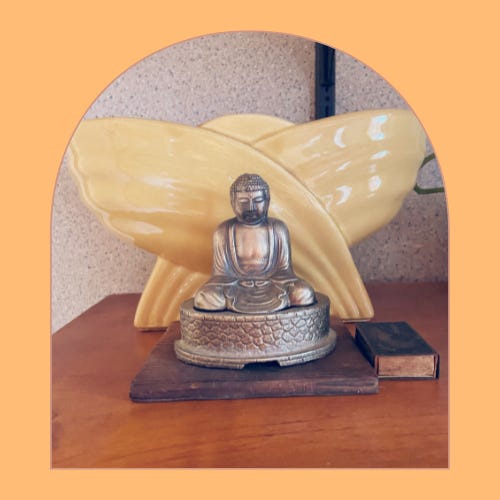IMAGE ID: A Buddha statue. Also, do you want to hear a joke? A tourist asked a New Yorker how to get to Carnegie Hall. And the New Yorker said, “Practice. Practice. Practice.”
Hello you — Adreanna here with this week’s dispatch of The Laundry,
You will rarely, if ever, hear me call myself a Buddhist. This is solely a personal choice, a stylistic proclivity, not a matter of what’s right or wrong. I’ve taken my vows and have a Sanskrit name and a lineage affiliation. I can rattle off the Four Noble Truths, the Eightfold Path, the Three Marks of Existence and the difference between the yanas. I am, by all definitions, as much of a card carrying Buddhist as they come. I’ve just found that it keeps me more honest when I remind myself that I’m not so much of a Buddhist as I am a Buddhist practitioner.
The identifying feature is that as a practitioner, Buddhism is something that I pick up and do (sometimes more successfully than others) on a daily basis. There’s no leaning back into the warm comfort of self-referencing labels, in the way that I might when I say that I’m a foodie or a mother or a redhead (once vibrantly natural, now in my forties with help). I know myself well enough to know that this would be a trap; a permission slip of sorts to practice meditation when it suits me, and otherwise just rest on my laurels as a Buddhist.
The same thing would likely happen if I called myself a writer. Knowing myself as a writing practitioner keeps me honest to the pivotal piece that writing (and Buddhism) requires: it’s something that I do, often ingloriously, rather than something that I passively AM.
For me, this emphasis on active participation isn’t about reaching to do all of the Buddhism, all of the time, like an extreme philosophical sport or something. I’ve long felt that any single teaching taken to heart and practiced consistently with sincerity has the potential to change one’s life by changing one’s outlook. And this is if one even identifies with Buddhism or not.
Buddhism doesn’t own the key concepts that it points to. There’s very little that’s shocking or mystical or even unique in Buddhist principles. Just speaking for myself, this is a part of what draws me to it. Many of these teachings sound obvious, like common sense. I imagine that’s why these teachings are called the “dharma,” which means “the way of things.” It’s a guide for squaring ourselves with reality.
Take the very first teaching on the First Noble Truth, for instance. It’s a very plain acknowledgement that being a human means that we will experience discomfort on a broad-range spectrum: everything from from dissatisfaction and annoyance to full blown trauma and suffering. This is unavoidable; it’s a packaged deal with joy and pleasure. And it’s not just you; every single person on this planet experiences suffering too.
This teaching doesn’t necessarily have WOW factor. It isn’t proprietarily “Buddhist.” If anything, to say that people experience discomfort names something almost numbingly obvious: most of us experience low grade annoyance on the best of days, and you don’t need to look far to find examples of full blown human suffering.
But what if we actually took the fact of discomfort to heart, as a practice, to the point that it informed our daily life?
Keep reading with a 7-day free trial
Subscribe to The Laundry to keep reading this post and get 7 days of free access to the full post archives.







